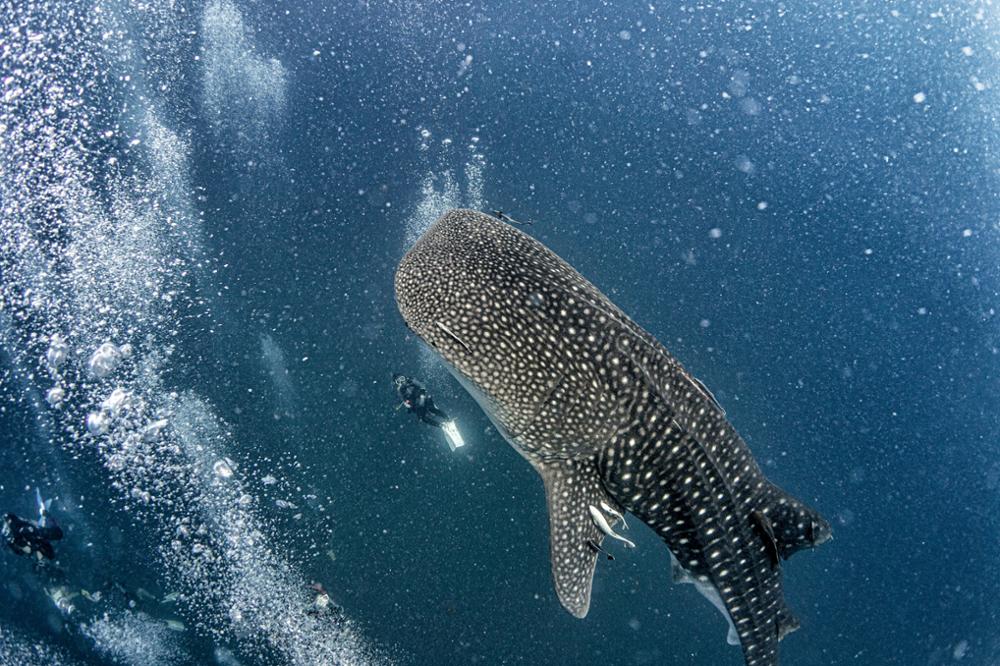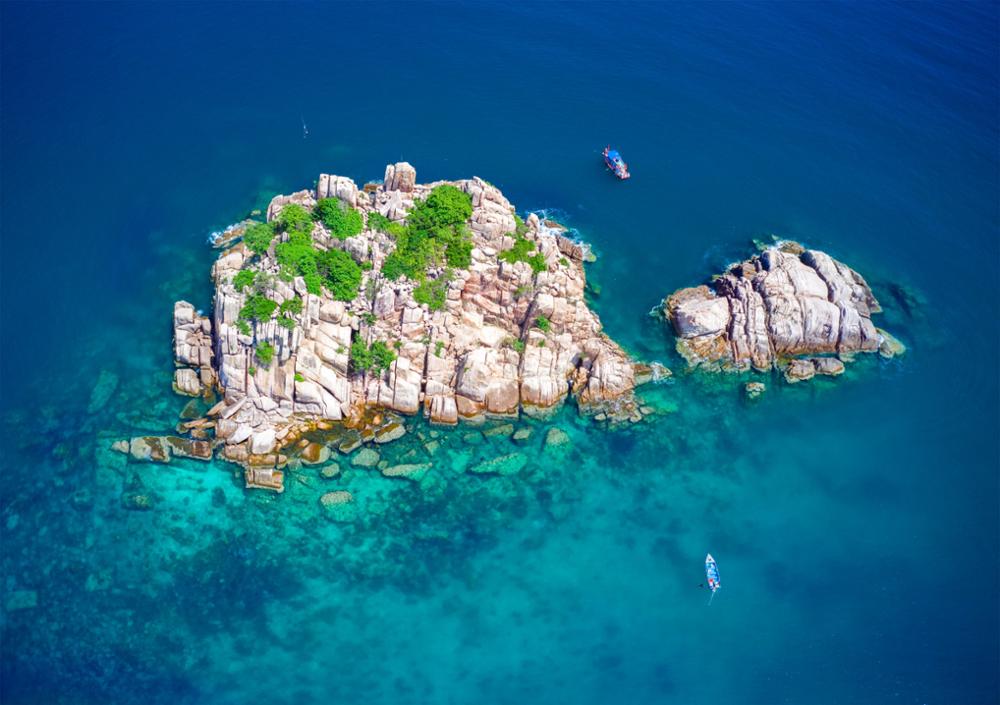Thailand
Best Diving Sites in Koh Tao
Surrounded by more than 8 km of coral reefs, the island of Koh Tao is among Thailand's top diving destinations. It also offers some of the world’s most affordable diving courses. Discover the best diving sites in Koh Tao, whether you’re a beginner or an experienced diver!
Chumphon Pinnacle

Depth: Minimum 14 m - Maximum 40 m
Diving Level: Intermediate divers (Open Water level or higher)
Ideal for the Deep Diver specialty.
Chumphon Pinnacle is considered by many to be the best diving site in Koh Tao. It features a deep pinnacle with many crevices, covered with carpets of anemones, sponges, and corals. Above the pinnacle, you can see impressive schools of fish, including yellowtail and chevron barracudas, snappers, batfish, jacks, and fusiliers. Close to the rock formations, you’ll encounter colonies of pink anemonefish, large marbled groupers, moray eels, angelfish, bannerfish, and triggerfish.
In terms of macro life, you’ll find creatures like banded boxer shrimp, Janns pipefish, and many species of nudibranchs. This site is also one of the best spots for whale sharks (depending on the season and a bit of luck).
South West Pinnacle
Depth: Minimum 5 m - Maximum 30 m
Diving Level: Intermediate and advanced divers (Open Water, Advanced Open Water, or higher)
South West Pinnacle is one of the most beautiful dive sites in Koh Tao. This site consists of seven granite pinnacles topped with vibrant green, pink, and blue anemones. The rock walls are adorned with gorgonians, red harp coral, and whip coral.
You’ll see schools of snappers, yellowtail barracudas, jacks, fusiliers, and sometimes even tuna. Along the walls and in crevices, large groupers, moray eels, blue-spotted stingrays, and even scorpionfish can be spotted. The site also offers an abundance of macro life, such as boxer shrimp, Durban dancing shrimp, and crabs.
Green Rock
Depth: Minimum 5 m - Maximum 30 m
Diving Level: Intermediate divers (Open Water level or higher)
Ideal for practicing buoyancy control.
Located off the northern coast of Koh Nang Yuan, northwest of Koh Tao, Green Rock is a dive site with large rock formations, including arches, tunnels, caverns, caves, and crevices, making it a great playground for divers.
This underwater cave network is home to a rich biodiversity. Schools of yellowtail barracudas can be seen at the top of the rocks, with a variety of fish such as batfish, angelfish, butterflyfish, and harlequin sweetlips found at greater depths. Hawksbill and green sea turtles can also occasionally be seen.
Notably, the site is famous for two species found in the north: titan and yellow-margin triggerfish (also known as giant triggerfish). These territorial species can be aggressive during their breeding season (April/May).
White Rock

Depth: Minimum 2 m - Maximum 22 m
Diving Level: Suitable for beginner to experienced divers
Ideal for the Night Diver specialty.
White Rock is the largest dive site by area in Koh Tao, featuring two large rock formations surrounded by a beautiful coral garden and a sandy area.
In addition to various hard and soft corals, the site is home to many species. At shallow depths, you’ll find schools of yellowtail barracudas and typical tropical fish of the Gulf of Thailand (such as angelfish, butterflyfish, and bannerfish). Sea turtles are also frequent visitors.
Close to the rock walls, you can see groupers, moray eels, sea snakes, and moral eels. Stingrays hide beneath ledges as well. When conditions are favorable, White Rock is an excellent night diving site, where you can observe nocturnal species such as squid and octopus hunting.
Twins Pinnacle
Depth: Minimum 5 m - Maximum 20 m
Diving Level: Suitable for beginner to experienced divers
Ideal for buoyancy training and specialties like Underwater Naturalist and Photography/Videography.
Twins Pinnacle, with its sheltered location and diverse marine life, is one of Koh Tao’s most popular dive sites. Protected from currents, it’s accessible year-round.
Despite its name, Twins Pinnacle actually comprises three pinnacles (two main formations and a smaller rock cluster). The site is home to longface emperor fish, boxfish, porcupinefish, parrotfish, bannerfish, triggerfish, and sometimes even green and hawksbill turtles.
Nestled in crevices, you may also spot stingrays and large groupers, along with various macro species like seahorses, nudibranchs, and pipefish.
The site also features Buoyancy World—artificial structures (concrete animal sculptures, tunnels, hoops) installed by local communities to promote marine life and offer buoyancy practice for divers.
Japanese Garden
Depth: Minimum 1 m - Maximum 16 m
Diving Level: Suitable for beginner divers and snorkelers
One of Koh Tao’s best snorkeling sites.
Located on the beautiful island of Koh Nang Yuan, Japanese Garden is easy to access and shallow, making it popular with beginner divers, snorkelers, and freedivers.
This site is known for its lovely gardens of hard and soft corals, featuring brain corals, lobe corals, staghorn corals, lettuce corals, table corals, giant sponges, and anemones.
The coral gardens host a variety of reef fish: butterflyfish, bannerfish, parrotfish, damselfish, squirrelfish, giant pufferfish, clownfish, and moorish idols. You may also spot moray eels, sea snakes, cuttlefish, stingrays, and many nudibranchs.
Shark Island

Depth: Minimum 0 m - Maximum 28 m
Diving Level: Suitable for beginner, intermediate, and advanced divers
Also great for snorkelers and freedivers.
Located less than 1 km southeast of Koh Tao, Shark Island is an uninhabited granite island rising 10 m above the sea, extending to depths of 15 m with additional scattered rocks reaching 28 m. Its name comes not from sharks but from its fin-like shape.
The site is famous for its vibrant coral life, with whip corals, soft corals, brain corals, whip corals, sponges, gorgonians, and sea anemones.
Marine life includes angelfish, butterflyfish, snappers, batfish, jacks, chevron barracudas, pufferfish, titan triggerfish, and sometimes hawksbill turtles and stingrays in sandy areas. Close to the rocks, you may spot large groupers, yellow boxfish, harlequin sweetlips, moray eels, and nudibranchs.
HTMS Sattakut (wreck dive)

Depth: Minimum 18 m - Maximum 30 m
Diving level: Intermediate and advanced divers (Advanced Open Water level)
Ideal for the wreck diver specialty.
Looking for a wreck dive? Head to the HTMS Sattakut site. This former Thai warship, donated by the U.S. Navy after WWII, served as a troop transport during the Battle of Iwo Jima. It was intentionally sunk in 2011 to create an artificial reef.
The ship lies at a depth of 30 m, with its mast at 18 m. It measures 49 m in length and 7 m in width. The wreck is in excellent condition, with its anti-aircraft guns still visible at the bow and stern, along with stairs, a front cabin, and more.
Experienced divers certified in Wreck Diver specialty can explore the interior and discover its rooms and secrets.
Although it’s not the most biodiverse site, you can still see giant groupers, snappers, butterflyfish, and yellowtail barracudas.
Sail Rock

Depth: Minimum 1 m - Maximum 40 m
Diving Level: Suitable for beginner to advanced divers
One of the furthest dive sites from Koh Tao but among the most beautiful in Thailand.
Located in open sea between Koh Tao and Koh Phangan, Sail Rock is considered one of Thailand’s best diving sites. Although it’s a 2-hour boat ride from Koh Tao, it’s well worth the trip!
This impressive granite pinnacle rises 15 m above the sea, with the main structure descending to 20 m and additional rock formations reaching depths of up to 40 m. Its unique feature? Sail Rock has a striking vertical chimney that divers can enter at 18 m depth and exit at 12 or 6 m.
In terms of marine life, Sail Rock is known for its impressive schools of fish, including yellowtail and chevron barracudas, batfish, snappers, and jacks. Close to the rock walls, you’ll see numerous reef fish such as angelfish, butterflyfish, and parrotfish.
Inside the chimney, an entire ecosystem has taken up residence. You’ll spot giant groupers, yellow boxfish, and moray eels hiding among the rocks, along with ghost shrimp, wart slugs, and many types of nudibranchs.
Finally, Sail Rock is one of Thailand’s best sites for spotting whale sharks, but it requires a bit of luck and the right season (from January to May).
Practical information
Best time to dive in Koh Tao
Although diving is possible year-round, the best season runs from January to August, offering optimal visibility and a chance to see whale sharks. Avoid November to December (rainy season), when visibility is poorer.
Water temperature in Koh Tao
The average water temperature is 29°C year-round, reaching up to 32°C in May.
Florine Dergelet

